- Home
- Oliver Sacks
Hallucinations Page 12
Hallucinations Read online
Page 12
2. Quite by accident, Hofmann discovered the hallucinogenic powers of LSD when he synthesized a new batch of the chemical in 1943. He must have absorbed some through his fingertips, for later that day he began to feel odd and went home, thinking he had a cold. As he lay in bed, he experienced “an uninterrupted stream of fantastic images of extraordinary plasticity and vividness and accompanied by an intense kaleidoscopic play of colors.” Jay Stevens, in his book Storming Heaven: LSD and the American Dream, recounted what came next:
Suspecting that LSD-25 had caused these fireworks, Hofmann decided to test this hypothesis.… [A few days later] he dissolved what he thought was a prudently infinitesimal amount of the drug—250 millionths of a gram—in a glass of water and drank it down. [Forty minutes later] he recorded a growing dizziness, some visual disturbance, and a marked desire to laugh. Forty-two words later he stopped writing altogether and asked one of his lab assistants to call a doctor before accompanying him home. Then he climbed onto his bicycle—wartime shortages having made automobiles impractical—and pedaled off into a suddenly anarchic universe.
3. I am quoting from the translation provided by David Ebin in his excellent book The Drug Experience: First-Person Accounts of Addicts, Writers, Scientists, and Others.
4. Louis Lewin, a German pharmacologist, published the first scientific analysis of the peyote cactus in 1886, and it was named Anhalonium lewinii in his honor. Later, he sought to classify various psychoactive substances based on their pharmacological effects, and he divided them into five general groups: euphoriants or sedatives (like opium), inebriants (like alcohol), hypnotics (like chloral and kava), excitants (like amphetamine and coffee), and hallucinogens, which he called phantastica. Many drugs, he noted, had overlapping and paradoxical effects, so that stimulants or sedatives could sometimes be as hallucinogenic as peyote.
5. Benny Shanon uses this phrase as the title of his remarkable book The Antipodes of the Mind, which is based on personal experience as well as extensive cultural and anthropological experience with the South American hallucinogen ayahuasca. Ayahuasca is, in fact, a blend of two plants: Psychotria viridis and Banisteriopsis caapi, neither of which has any hallucinogenic power by itself. The leaves of Psychotria contain dimethyltryptamine (DMT), a very powerful hallucinogen—but DMT, if taken by mouth, is deactivated in the gut by monoamine oxidase (MAO). Banisteriopsis, however, contains compounds that inhibit the MAO and so allow the DMT to be absorbed. “When one thinks about it,” Shanon writes, “the discovery of Ayahuasca is indeed amazing. The number of plants in the rain forest is enormous, the number of their possible pairings astronomical. The common sense method of trial and error would not seem to apply.”
6. Breslaw’s account is included in David Ebin’s book The Drug Experience.
7. I have discussed neurological aspects of time and motion perception, as well as cinematic vision, at greater length in two articles, “Speed” and “In the River of Consciousness.”
8. Very little was known in the early 1960s about how psychoactive drugs worked, and early research by Timothy Leary and others at Harvard, as well as the work of L. Jolyon West and Ronald K. Siegel at UCLA in the 1970s, focused mostly on the experiences of hallucinogens rather than their mechanisms. In 1975, Siegel and West published a wide-ranging collection of essays in their book Hallucinations: Behavior, Experience, and Theory. Here West set out (as he had in previous work) his release theory of hallucination.
It is now known that stimulants like cocaine and the amphetamines stimulate the “reward systems” of the brain, which are largely mediated by the neurotransmitter dopamine; this is also the case with opiates and alcohol. The classical hallucinogens—mescaline, psilocybin, LSD, and probably DMT—act by boosting serotonin in the brain.
9. When, decades later, I told this story to my friend Tom Eisner, an entomologist, I mentioned the spider’s philosophical tendencies and Russellian voice. He nodded sagely and said, “Yes, I know the species.”
10. Many years later, I experienced the much gentler effects of sakau, the intoxicating sap of a pepper (Piper methysticum, also called kava in Polynesia) cultivated in the South Pacific. Drinking sakau has been a central part of Micronesian life, as chewing coca leaves has been in the Andes, for thousands of years; and its use is formalized in elaborate sakau rituals. I described the effects of sakau at length in The Island of the Colorblind; it may evoke a delicious sense of floating and ease, as well as a variety of visual illusions or hallucinations.
7
Patterns: Visual Migraines
I have had migraines for most of my life; the first attack I remember occurred when I was three or four years old. I was playing in the garden when a shimmering light appeared to my left, dazzlingly bright. It expanded, becoming an enormous arc stretching from the ground to the sky, with sharp, glittering, zigzagging borders and brilliant blue and orange colors. Then behind the brightness came a growing blindness, an emptiness in the field of vision, and soon I could see almost nothing on my left side. I was terrified—what was happening? My sight returned to normal in a few minutes, but these were the longest minutes I had ever experienced.
I told my mother what had happened, and she explained to me that what I had had was a migraine aura—a feeling or sensation that precedes a migraine; she was a doctor, and she too was a “migraineur.” It was a visual migraine aura, and the characteristic zigzag shape, she would later tell me, resembled that of medieval forts, so it was often called a fortification pattern. Many people, she said, would get a terrible headache after seeing the aura.
I was lucky to be one of those people who got only the aura without the headache, and lucky, too, to have a mother who could reassure me that everything would be back to normal within a few minutes, and with whom, as I got older, I could share my migraine experiences. She explained that auras like mine were due to a sort of electrical disturbance like a wave passing across the visual parts of the brain. A similar “wave” could pass over other parts of the brain, too, she said, so one might get a strange feeling on one side of the body or experience an odd smell or find oneself temporarily unable to speak. A migraine might affect one’s perception of color or depth or movement, might make the whole visual world unintelligible for a few minutes. Then, if one were unlucky, the rest of the migraine would follow: violent headaches, vomiting, painful sensitivity to light and noise, abdominal disturbances, and a host of other symptoms.1 Migraine was common, my mother said, affecting at least 10 percent of the population. Its classic visual presentation is a scintillating, zigzag-edged, kidney-shaped form like the one I saw, expanding and moving slowly across one half of the visual field over the course of fifteen or twenty minutes. Inside the shimmering borders of this shape is often a blind area, a scotoma—thus the whole shape is called a scintillating scotoma.
For most people with classical migraine, the scintillating scotoma is the chief visual effect, and things go no further. But sometimes, within the scotoma, there are other patterns. In my own migraine auras, I would sometimes see—vividly with closed eyes, more faintly and transparently if I kept my eyes open—tiny branching lines like twigs or geometrical structures: lattices, checkerboards, cobwebs, and honeycombs. Unlike the scintillating scotoma itself, which had a fixed appearance and a slow, steady rate of progression, these patterns were in continual motion, forming and re-forming, sometimes assembling themselves into more complicated forms like Turkish carpets or complex mosaics or three-dimensional shapes like tiny pinecones or sea urchins. Usually these patterns stayed inside the scotoma, to one side or the other of my visual field, but sometimes they seemed to break loose and scatter themselves all over.
One has to call these hallucinations, even though they are only patterns and not images, for there is nothing in the external world that corresponds to the zigzags and checkerboards—they are generated by the brain. And there may also be startling perceptual changes with migraine. I might sometimes lose the sense of color or of depth (for other people, color
or depth may intensify). Losing the sense of movement was especially startling, for instead of continuous movement, I would see only a stuttering series of “stills.” Objects might change size or shape or distance, or get misplaced in the visual field so that, for a minute or two, the whole visual world would be unintelligible.
There are many variations on the visual experiences of migraine. Jesse R. wrote to me that during a migraine, “I think my mind loses its ability to read shapes and misinterprets them.… I think I see a person instead of the coat rack … or I often think I see movement across a table or floor. What is strange is that the mind always errs toward giving life to inanimate objects.”
Toni P. wrote that before her migraines, she might see alternating black and white zigzag lines in her peripheral vision: “shiny geometric shapes, flashes of light. Sometimes it is as if whatever I am viewing is through a sheer curtain that is blowing in the wind.” But sometimes, for her, a scotoma is simply a blank spot, producing an uncanny sense of nothingness:
I was studying for a major lab exam when all of a sudden I knew something was missing—the book was in front of me; I could see the edges, but there were no words, no graphs, no diagrams. It wasn’t as if there was a blank page, it just didn’t exist. I only knew it SHOULD be there by reason. That was the strangeness of it.… It lasted for about twenty minutes.
Another woman, Deborah D., had an attack of migraine in which, she wrote:
When I looked at the computer screen, I could not read anything; the screen was a crazy blur … of multiple images.… I could not see the numbers on the phone’s keypad, it was as if I was seeing through a fly’s lens, multiple images, not double, not triple, but many, many images of wherever I looked.
It is not only the visual world that may be affected in a migraine aura. There may be hallucinations of body image—the feeling that one is taller or shorter, that one limb has shrunk or grown gigantic, that one’s body is tilted at an angle, and so forth.
It is known that Lewis Carroll had classical migraines, and it has been suggested (by Caro W. Lippman and others) that his migraine experiences may have inspired Alice in Wonderland’s strange alterations of size and shape. Siri Hustvedt, in a New York Times blog, described her own transcendent Alice-in-Wonderland syndrome:
As a child I had what I called “lifting feelings.” Every once in a while I had a powerful internal sensation of being pulled upward, as if my head were rising, even though I knew my feet hadn’t left the ground. This lift was accompanied by what can only be called awe—a feeling of transcendence. I variously interpreted these elevations as divine (God was calling) or as an amazed connection to things in the world. Everything appeared strange and wondrous.
There may be auditory misperceptions and hallucinations in migraine: sounds are amplified, reverberant, distorted; occasionally voices or music are heard. Time itself may seem distorted.
Hallucinations of smell are not uncommon—the smells are often intense, unpleasant, strangely familiar, yet unspecifiable. I myself twice hallucinated a smell before a migraine, but a pleasant one—the smell of buttered toast. The first time it happened, I was at the hospital and went in search of the toast—it did not occur to me that I was having a hallucination until the visual fortifications started up, a few minutes later. On both occasions there was a memory or pseudomemory of being a little boy in a high chair about to have buttered toast at teatime. One migraineur wrote to me, “I have always smelled beef roasting about thirty minutes before the onset of a migraine.”2 A patient described by G. N. Fuller and R. J. Guiloff had “vivid olfactory hallucinations, lasting five minutes, of either her grandfather’s cigars or peanut butter.”
When I worked in a migraine clinic as a young neurologist, I made a point of asking every patient about such experiences. They were usually relieved that I asked, for people are afraid to mention hallucinations, fearing that they will be seen as psychotic. Many of my patients habitually saw patterns in their migraine auras, and a few had a host of other strange visual phenomena, including distortion of faces or objects melting or flickering into one another; multiplication of objects or figures; or persistence or recurrence of visual images.
Most migraine auras remain at the level of elementary hallucinations: phosphenes, fortifications, and geometrical figures of other sorts—but more complex hallucinations, though rare in migraine, do occur. My colleague Mark Green, a neurologist, described to me how one of his patients had the same vision in every migraine attack: a hallucination of a worker emerging from a manhole in the street, wearing a white hard hat with an American flag painted on it.
S. A. Kinnier Wilson, in his encyclopedic Neurology, described how a friend of his would always have a stereotyped hallucination as part of a migraine aura:
[He] used at first to see a large room with three tall arched windows and a figure clad in white (its back toward him) seated or standing at a long bare table; for years this was the unvarying aura, but it was gradually replaced by a cruder form (circles and spirals), which, later still, developed once in a while without subsequent headache.
Klaus Podoll and Derek Robinson, in their beautifully illustrated monograph Migraine Art, have collected many reports of complex hallucinations in migraine from the world literature. People may see human figures, animals, faces, objects, or landscapes—often multiplied. One man reported seeing “a fly’s eye made of millions of light-blue Mickey Mouses” during a migraine attack, but this hallucination was confined to the temporarily blind half of his visual field. Another saw a “crowd of [more than] one hundred people, some dressed in white.”
There may also be lexical hallucinations. Podoll and Robinson cite a case from the nineteenth-century literature:
A patient of Hoeflmayr’s saw words written in the air; a patient of Schob’s had hallucinations of letters, words, and numbers; and a patient reported by Fuller et al. “saw writing on the wall and when asked what it was said he was too far from it. He then walked up to the wall and was able to read it out clearly.”
Lilliputian hallucinations can occur in migraine (as well as in other conditions), as Siri Hustvedt described in a New York Times blog:
I was lying in bed reading a book by Italo Svevo, and for some reason, looked down, and there they were: a small pink man and his pink ox, perhaps six or seven inches high. They were perfectly made creatures and, except for their color, they looked very real. They didn’t speak to me, but they walked around, and I watched them with fascination and a kind of amiable tenderness. They stayed for some minutes and then disappeared. I have often wished they would return, but they never have.
All of these effects seem to show, by default, what a colossal and complicated achievement normal vision is, as the brain constructs a visual world in which color and movement and size and form and stability are all seamlessly meshed and integrated. I came to regard my own migraine experiences as a sort of spontaneous (and fortunately reversible) experiment of nature, a window into the nervous system—and I think this was one reason I decided to become a neurologist.
What is stirring up the visual system during a migraine attack, to provoke such hallucinations? William Gowers, writing more than a century ago, when little was known of the cellular details of the visual cortex (or the brain’s electrical activity), addressed this question in The Border-land of Epilepsy:
The process which gives rise to the sensory symptoms … of migraine is very mysterious.… There is a peculiar form of activity which seems to spread, like the ripples in a pond into which a stone is thrown. But the activity is slow, deliberate, occupying twenty minutes or so in passing through the centre affected. In the region through which the active ripple waves have passed, a state is left like molecular disturbance of the structures.
Gowers’s intuition proved quite accurate and was given physiological backing decades later, when it was discovered that a wave of electrical excitation could track across the cerebral cortex at much the same rate the fortifications did. In 1971, Whitman Ri
chards suggested that the zigzag shape of migraine fortification patterns, with its characteristic angles, might reflect something equally constant in the architecture of the visual cortex itself—perhaps clusters of the orientation-sensitive neurons which Hubel and Wiesel had demonstrated in the early 1960s. As the wave of electrical excitation slowly marches across the cortex, Richards suggested, it might directly stimulate these clusters, causing the patient to “see” shimmering bars of light at different angles. But it was only with the use of magnetoencephalography, twenty years later, that it was possible to demonstrate that the passage of fortifications in a migraine aura was indeed accompanied by just such a wave of electrical excitation.
A hundred and fifty years ago, the astronomer Hubert Airy (who was a migraineur himself) felt that the aura of migraine provided “a sort of photograph” of the brain in action. He, like Gowers, may have been more literally accurate than he knew.
Heinrich Klüver, writing about mescal, remarked that the simple geometric hallucinations one might get with hallucinogenic drugs were identical to those found in migraine and many other conditions. Such geometrical forms, he felt, were not dependent on memory or personal experience or desire or imagination; they were built into the very architecture of the brain’s visual systems.
But while the zigzag fortification patterns are highly stereotyped and can perhaps be understood in terms of the orientation receptors in the primary visual cortex, a different sort of explanation must be sought for the rapidly changing, permuting play of geometric forms. Here we need dynamic explanations, a consideration of the ways in which the activity of millions of nerve cells can produce complex and ever-changing patterns. We can actually see, through such hallucinations, something of the dynamics of a large population of living nerve cells and, in particular, the role of self-organization in allowing complex patterns of activity to emerge. Such activity operates at a basic cellular level, far beneath the level of personal experience. The hallucinatory forms are, in this way, physiological universals of human experience.

 Uncle Tungsten
Uncle Tungsten Oaxaca Journal
Oaxaca Journal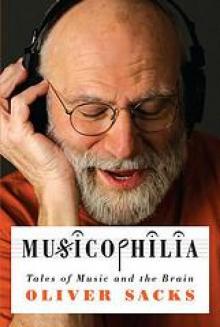 Musicophilia
Musicophilia The man who mistook his wife for a hat
The man who mistook his wife for a hat 1989 - Seeing Voices
1989 - Seeing Voices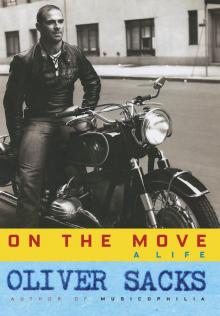 On the Move: A Life
On the Move: A Life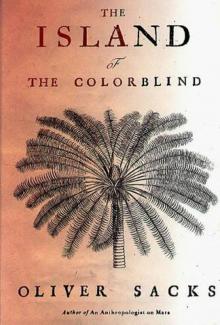 1996 - The Island of the Colorblind
1996 - The Island of the Colorblind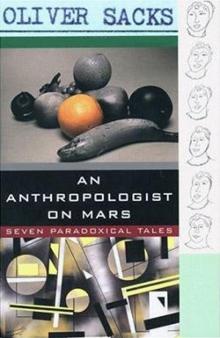 An Anthropologist on Mars: Seven Paradoxical Tales
An Anthropologist on Mars: Seven Paradoxical Tales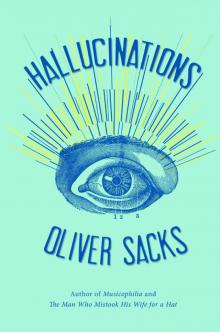 Hallucinations
Hallucinations Seeing Voices
Seeing Voices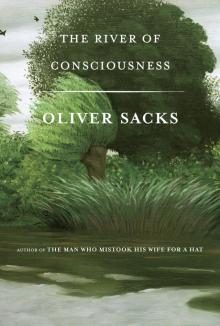 The River of Consciousness
The River of Consciousness Vintage Sacks
Vintage Sacks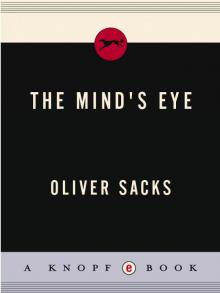 The Mind's Eye
The Mind's Eye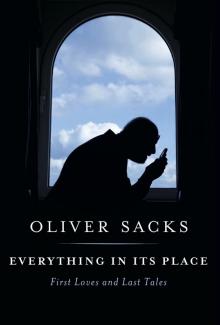 Everything in Its Place
Everything in Its Place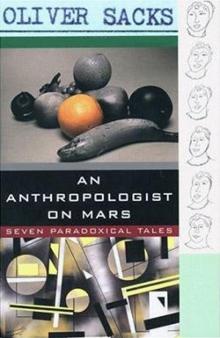 An Anthropologist on Mars (1995)
An Anthropologist on Mars (1995) Uncle Tungsten: Memories of a Chemical Boyhood (2001)
Uncle Tungsten: Memories of a Chemical Boyhood (2001)